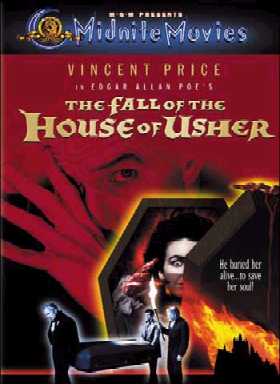 THE
FALL OF THE HOUSE OF USHER (1960)
THE
FALL OF THE HOUSE OF USHER (1960)Director: Roger Corman
MGM
 THE
FALL OF THE HOUSE OF USHER (1960)
THE
FALL OF THE HOUSE OF USHER (1960)During the 50s, American International Pictures (AIP) was known for churning out cheapie black and white films that were produced specifically to play as double bills on the drive-in circuit. Roger Corman, the ace director behind many of these exploiters, came up with a new approach. Using the budget usually allotted for two AIP films, and with double the shooting time (15 days), Corman convinced Sam Arkoff and James Nicholson to let him make a color, CinemaScope horror film--based on a short Edgar Allan Poe story--to play alone. Arkoff needed some pursuing, since he questioned where the monster of the film was? Corman assuredly replied, "the house is the monster," as a new era in horror was born.
Scriptwriter Richard Matheson had to add a lot to Poe's original story, and he does so honorably. The plot concerns Philip Winthrop (Mark Damon) who arrives at the crumbling House of Usher to elope with his fiancée, Madeline (Myrna Fahey). Madeline's much older brother Roderick (Vincent Price) objects to their plans of marriage as he rants about the family's bloodline being cursed and doom being in store for him and his sister. Madeline grows weaker and eventually dies, but it's later discovered that she suffers from comatose, causing the ultimate horror--being buried alive.
Despite the low budget, Corman was able to construct a rich, lavish gothic horror film with a chilling suggestion of suffocating decay. Here he's aided by a talented team that would be responsible for the success of further Poe adaptations, including the breathtaking cinematography of Floyd Crosby, and the inventive art direction of Daniel Haller. The cast is narrowed down to four main characters, and the standout of course is Vincent Price, who Corman handpicked for the role. Price portrays Roderick as a long-suffering, obsessive type who scorns being touched and is sensitive to loud noises. Dying his hair white and ridding himself of the trademark mustache, Price is completely modified of his usual persona and he really holds the film together. This was the beginning of a long relationship between Price and AIP, and the popular actor would make dozens of films for them over the next decade and a half.
For anyone used to watching HOUSE OF USHER on television or videotape, MGM's new DVD (bearing the title "Fall of the House of Usher" on the packaging, but not the print) is a revelation. The transfer includes the film's original 2.35:1 aspect ratio that completely compliments Crosby's lavish Scope composition. The distinguished colors are simply scrumptious and there's only minor blemishes on the print source. The mono sound is fine, and the disc is also anamorphic.
What makes this release even more special is an audio commentary by director Corman. Corman has only recently began doing commentaries for his films, and this one is extremely enjoyable. He talks the viewer through the proceedings, giving interesting details on filming the opening sequence amid the aftermath of a Hollywood forest fire, the surreal family portraits, the superb matte paintings, the extravagantly fiery climax, and much more. Corman also discusses the cast and crew with great admiration and explains much of his inventive techniques, telling how he set up specific shots and such. The disc also has optional Spanish and French subtitles, and the original widescreen trailer is also included. (George R. Reis)